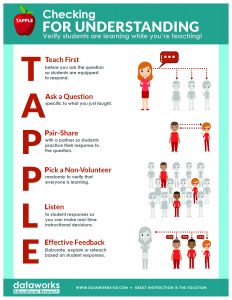“Pull a Stick” means Call on Non-Volunteers
A Strategy for Engaging Every Student

One of the most effective ways to engage all students in your classroom is by using a randomizing system to call on non-volunteers. “Pull a stick” has become a popular method where teachers call on non-volunteers by drawing Popsicle® sticks with student names from a cup. However, modern technology offers even more options, such as randomizing apps for computers, phones, and tablets.
Whether you use sticks or apps, the key is to ensure that every student has an equal chance of being selected. Calling on non-volunteers keeps everyone alert and engaged, as no one knows when their turn might come.
Why Randomizing Works

By calling on non-volunteers through randomization, you create an inclusive and dynamic classroom environment. This approach encourages all students to stay attentive and ready to participate, which not only improves classroom management but also ensures balanced engagement.
When non-volunteers are called on, you gain a better understanding of each student’s grasp of the material. This allows you to make data-driven decisions, such as identifying when to reteach or proceed with a lesson.
Calling on non-volunteers makes learning visible and ensures active participation from every student.
“Fake the Stick” – A Strategy for Intentional Student Engagement
While calling on non-volunteers randomly is an excellent way to engage students, there are moments when you might choose to “fake the stick” or intentionally select a student for a specific reason. This strategy can be useful in situations where a particular response is needed or when guiding the classroom discussion in a specific direction.
- Classroom management: You may choose to call on students who are not paying attention, helping to refocus them on the lesson.
- Encouraging Participation: While occasional repeats keep everyone engaged, if the same name comes up too often, it may be necessary to call on someone else to ensure variety in responses.
- Supporting Struggling Students: If you notice that a particular student is struggling, you can call on them as the 3rd or 4th student to answer a question. This gives them the benefit of hearing other students’ responses first, making it more likely they’ll answer correctly.
- Monitoring Student Progress: By observing whiteboards or pair-shares, you can identify when a struggling student has the correct answer. In this case, you can intentionally call on them to share their response, boosting their confidence and providing a real-time check of their understanding.
Use Volunteers for More Details
Of course, you can still call on volunteers occasionally. You can ask for volunteers to expand on the answer or provide additional insight. This differentiation strategy benefits high-performing students by offering them an opportunity to elaborate, while also ensuring that other students stay engaged and involved. You can also add a stick to the cup that says “Volunteer” or “Teacher’s Choice.” This adds fun to the lesson and class.
Let’s implement ‘Pull a Stick” in your classroom!
By incorporating the “pull a stick” method, or randomizing student responses, you can boost engagement, enhance learning, and create a classroom where every student has the chance to shine. Try it out and see how it transforms the dynamic in your class!
For more information about Checking for Understanding, check out our blog or explore our bestselling book on Explicit Direct Instruction. Contact us at info@dataworks-ed.com or call 800-495-1550.




